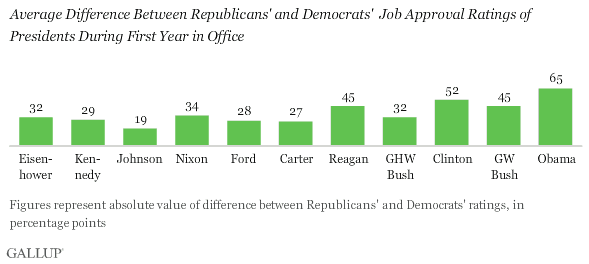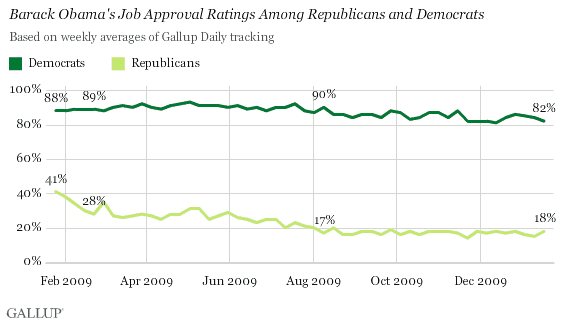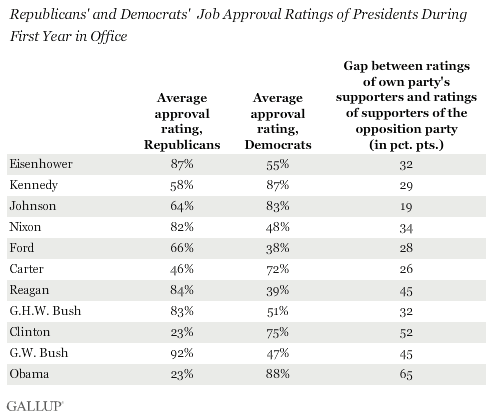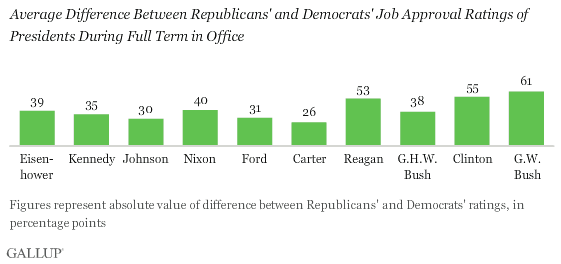PRINCETON, NJ -- The 65 percentage-point gap between Democrats' (88%) and Republicans' (23%) average job approval ratings for Barack Obama is easily the largest for any president in his first year in office, greatly exceeding the prior high of 52 points for Bill Clinton.

Overall, Obama averaged 57% job approval among all Americans from his inauguration to the end of his first full year on Jan. 19. He came into office seeking to unite the country, and his initial approval ratings ranked among the best for post-World War II presidents, including an average of 41% approval from Republicans in his first week in office. But he quickly lost most of his Republican support, with his approval rating among Republicans dropping below 30% in mid-February and below 20% in August. Throughout the year, his approval rating among Democrats exceeded 80%, and it showed little decline even as his overall approval rating fell from the mid-60s to roughly 50%.

"Prior to Ronald Reagan, no president averaged more than a 40-point gap in approval ratings by party during his term; since then, only the elder George Bush has averaged less than a 50-point gap."
Thus, the extraordinary level of polarization in Obama's first year in office is a combination of declining support from Republicans coupled with high and sustained approval from Democrats. In fact, his 88% average approval rating from his own party's supporters is exceeded only by George W. Bush's 92% during Bush's first year in office. Obama's 23% approval among supporters of the opposition party matches Bill Clinton's for the lowest for a first-year president. But Clinton was less popular among Democrats than Obama has been to date, making Obama's ratings more polarized.

Obama still has three years left in his first term and possibly seven more as president, so there is much time for the polarization of his approval ratings to subside. However, if the current level of polarization persists through the end of his term, Obama would exceed Bush as the president with the most polarized approval ratings.
Bush's average Republican-Democratic gap for his eight years in office was 61 points. This included the record gap for a single approval rating: 83 points, which occurred twice -- in September 2004 (95% Republican, 12% Democratic) and October 2004 (94% Republican, 11% Democratic).
The political divide in Bush's ratings is to some extent understated, though, given the rally in public support for Bush after the Sept. 11 terror attacks, when he received record-high approval ratings. Even with these approval ratings, he averaged a 55-point gap in approval by party during his first term. During his second term, the average party gap in his ratings was 68 points, higher than Obama's to date.
The accompanying graph makes clear how much the level of political polarization has grown in Americans' evaluations of presidents in recent decades. Prior to Ronald Reagan, no president averaged more than a 40-point gap in approval ratings by party during his term; since then, only the elder George Bush has averaged less than a 50-point gap, including Obama's average 65-point gap to date.

Bottom Line
As a candidate and as president, Obama -- like his immediate predecessor, Bush -- sought to bring Americans together after periods of heightened political polarization in the United States. But despite their best intentions and efforts, both men's approval ratings have been characterized by extreme partisanship -- with high and seemingly unwavering approval from their own party's supporters and very little from the opposition party.
The way Americans view presidents has clearly changed in recent decades, perhaps owing to the growth in variety, sources, and even politicization of news on cable television and the Internet, and the continuing popularity of politically oriented talk radio. The outcome is that Americans evaluate their presidents and other political leaders through increasingly thick partisan lenses.
